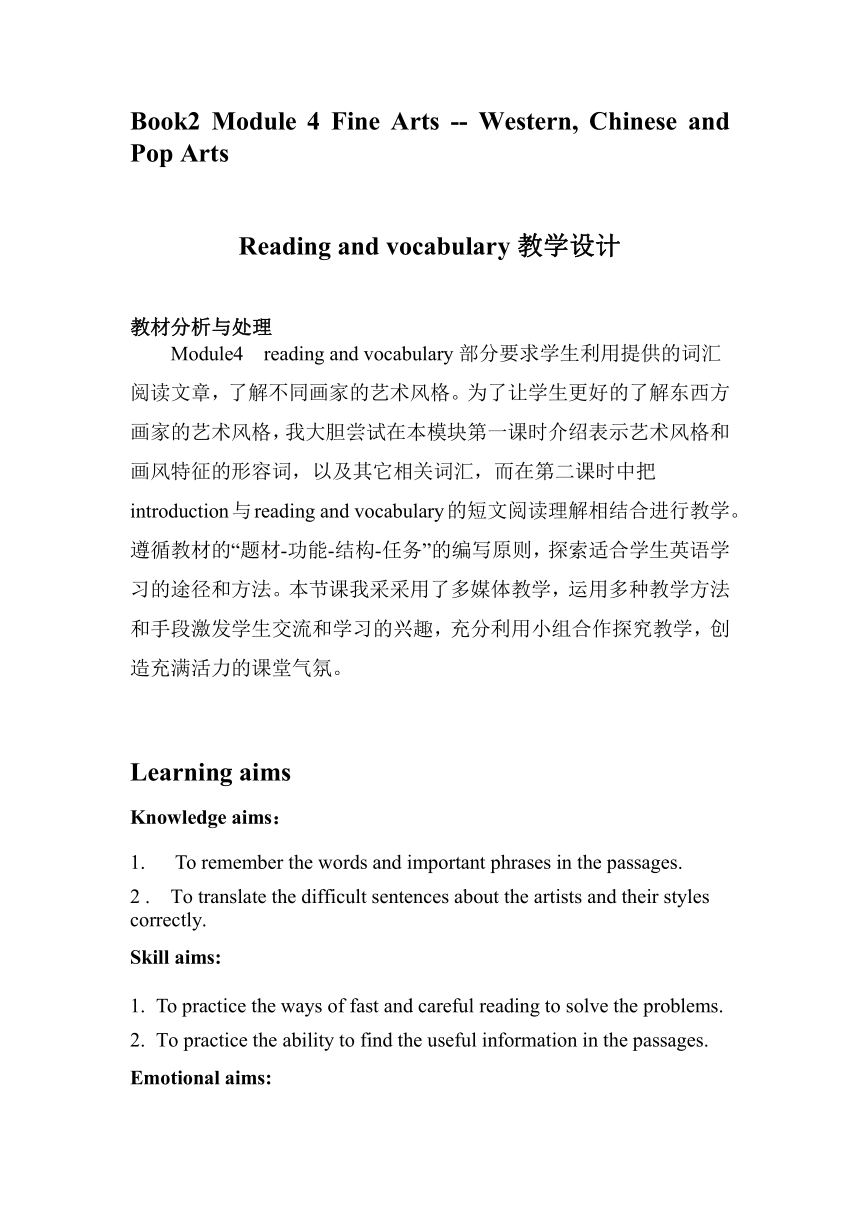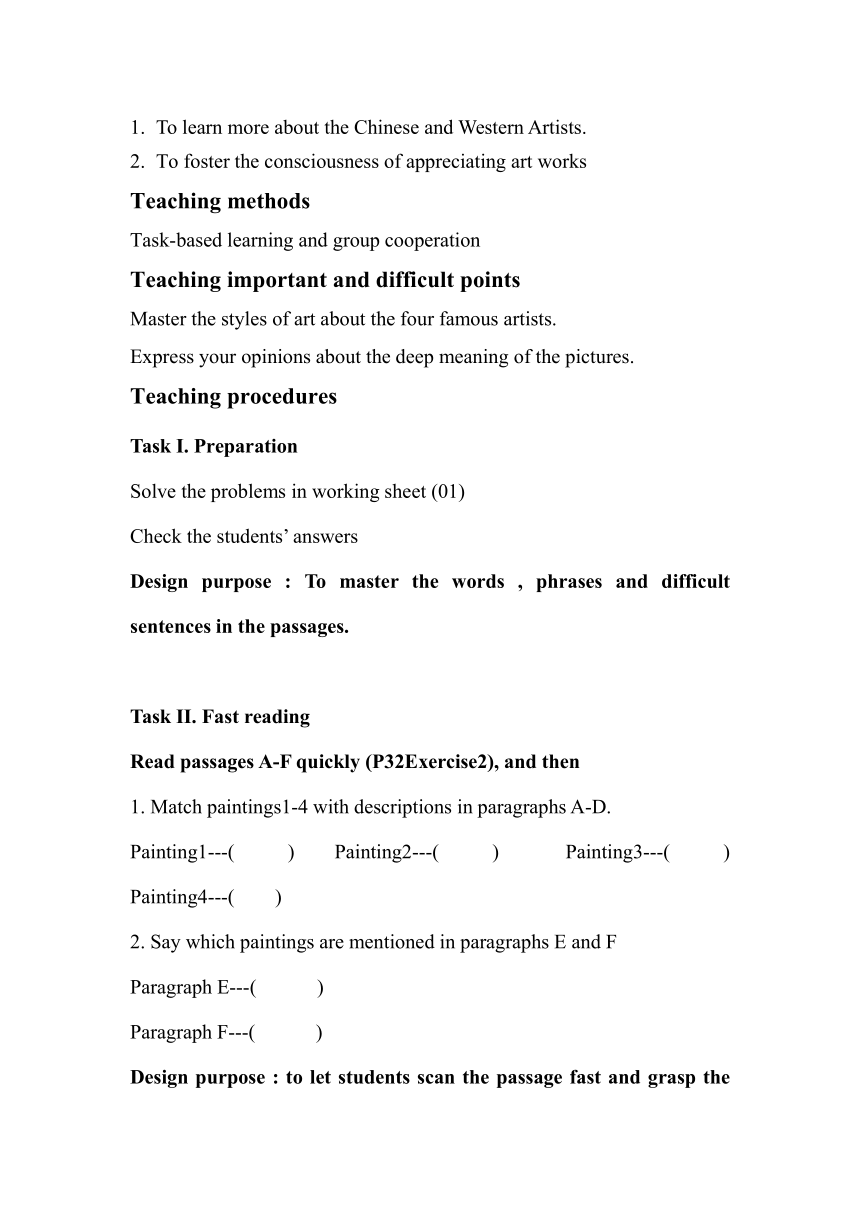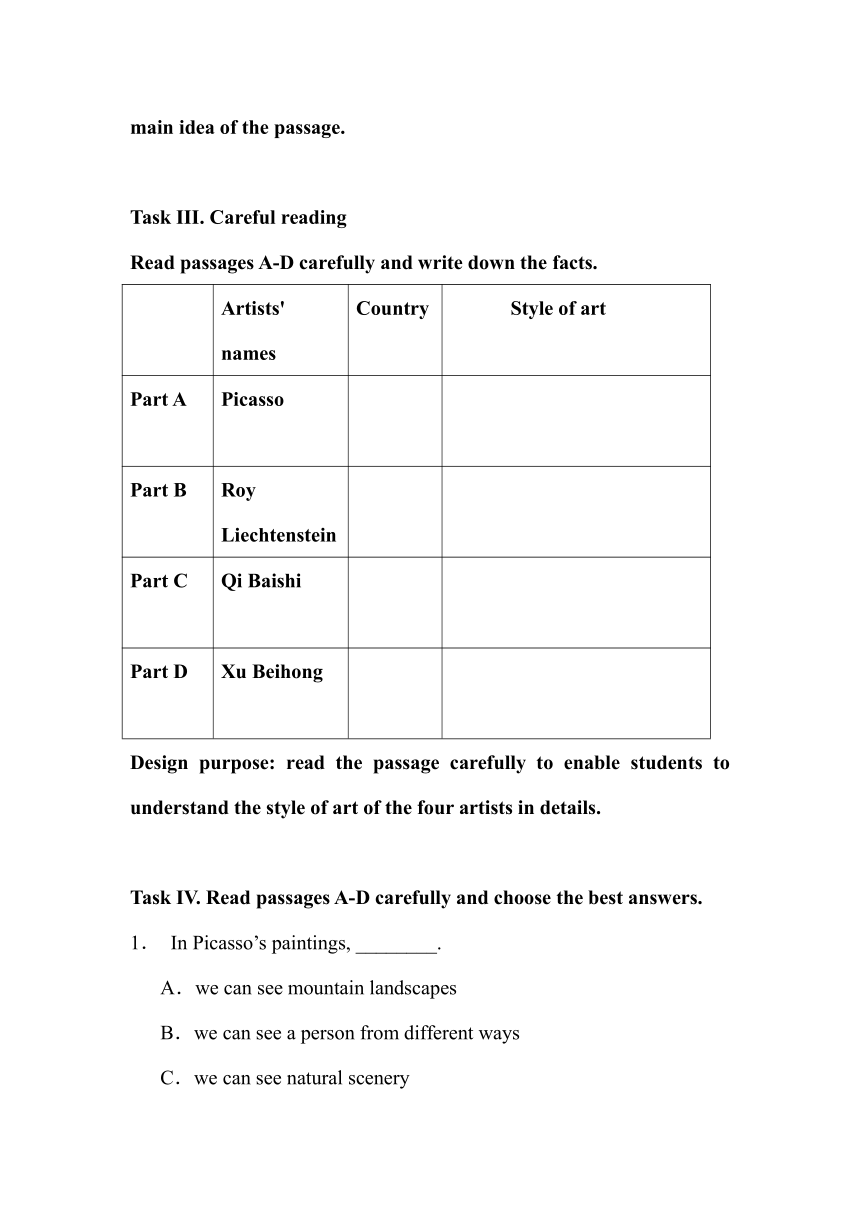外研版必修二Module 4 Fine Arts – Western, Chinese and Pop Arts-Readingandvocabulary教学设计
文档属性
| 名称 | 外研版必修二Module 4 Fine Arts – Western, Chinese and Pop Arts-Readingandvocabulary教学设计 |  | |
| 格式 | zip | ||
| 文件大小 | 21.0KB | ||
| 资源类型 | 教案 | ||
| 版本资源 | 外研版 | ||
| 科目 | 英语 | ||
| 更新时间 | 2021-12-23 17:36:06 | ||
图片预览



文档简介
Book2 Module 4 Fine Arts -- Western, Chinese and Pop Arts
Reading and vocabulary教学设计
教材分析与处理
Module4 reading and vocabulary部分要求学生利用提供的词汇阅读文章,了解不同画家的艺术风格。为了让学生更好的了解东西方画家的艺术风格,我大胆尝试在本模块第一课时介绍表示艺术风格和画风特征的形容词,以及其它相关词汇,而在第二课时中把introduction与reading and vocabulary的短文阅读理解相结合进行教学。遵循教材的“题材-功能-结构-任务”的编写原则,探索适合学生英语学习的途径和方法。本节课我采采用了多媒体教学,运用多种教学方法和手段激发学生交流和学习的兴趣,充分利用小组合作探究教学,创造充满活力的课堂气氛。
Learning aims
Knowledge aims:
1. To remember the words and important phrases in the passages.
2 . To translate the difficult sentences about the artists and their styles correctly.
Skill aims:
To practice the ways of fast and careful reading to solve the problems.
To practice the ability to find the useful information in the passages.
Emotional aims:
To learn more about the Chinese and Western Artists.
To foster the consciousness of appreciating art works
Teaching methods
Task-based learning and group cooperation
Teaching important and difficult points
Master the styles of art about the four famous artists.
Express your opinions about the deep meaning of the pictures.
Teaching procedures
Task I. Preparation
Solve the problems in working sheet (01)
Check the students’ answers
Design purpose : To master the words , phrases and difficult sentences in the passages.
Task II. Fast reading
Read passages A-F quickly (P32Exercise2), and then
1. Match paintings1-4 with descriptions in paragraphs A-D.
Painting1---( ) Painting2---( ) Painting3---( ) Painting4---( )
2. Say which paintings are mentioned in paragraphs E and F
Paragraph E---( )
Paragraph F---( )
Design purpose : to let students scan the passage fast and grasp the main idea of the passage.
Task III. Careful reading
Read passages A-D carefully and write down the facts.
Artists' names Country Style of art
Part A Picasso
Part B Roy Liechtenstein
Part C Qi Baishi
Part D Xu Beihong
Design purpose: read the passage carefully to enable students to understand the style of art of the four artists in details.
Task IV. Read passages A-D carefully and choose the best answers.
1. In Picasso’s paintings, ________.
A.we can see mountain landscapes
B.we can see a person from different ways
C.we can see natural scenery
D.we can see beautiful city life
2. From Paragraph B,we can see that ________.
A.Roy Lichtenstein is the representative of Cubism
B.Roy Lichtenstein is the representative of pop art
C.Roy Lichtenstein is good at showing twentieth-century life
D.Roy Lichtenstein is good at drawing soup cans and advertisements
3. Qi Baishi’s paintings are special because of his ________.
A.special painting style
B.traditional painting style
C.careful observation of the nature
D.brush drawings in black inks and natural colours
4. What Qi Baishi and Xu Beihong have in common is that________.
A.they imitate reality
B.they have famous paintings of horses
C.their brush line is beautiful
D.they observed the nature carefully
Design purpose:To help students learn the passages better and to check the students’ understanding about the passages.
Task V. Read passages E and F and fill in the form
Opinions of the paintings (key words)
Part E Wu Hang likes: dislikes:
Part F Sarah Hardwick
Design purpose:To deepen the understanding to the paintings of the artists, especially the students’ opinions for the paintings.
Task VI. Art appreciation
(1) Choose a picture you like /dislike and give a title for it.
(2) Describe each picture and tell us what the painter wants to express.(oral expression)
Picture Picture 1 Picture 2 Picture 3
Title
Opinions (key words)
Design purpose:To foster the students’ ability of art appreciation
Task VII. Conclusion (1min)
What is art
_____________________________________________________________________
Design purpose:to Summarize the lesson and improve the consciousness of appreciating art works
Task VIII. Homework :Finish exercises related to reading(03)
Reading and vocabulary教学设计
教材分析与处理
Module4 reading and vocabulary部分要求学生利用提供的词汇阅读文章,了解不同画家的艺术风格。为了让学生更好的了解东西方画家的艺术风格,我大胆尝试在本模块第一课时介绍表示艺术风格和画风特征的形容词,以及其它相关词汇,而在第二课时中把introduction与reading and vocabulary的短文阅读理解相结合进行教学。遵循教材的“题材-功能-结构-任务”的编写原则,探索适合学生英语学习的途径和方法。本节课我采采用了多媒体教学,运用多种教学方法和手段激发学生交流和学习的兴趣,充分利用小组合作探究教学,创造充满活力的课堂气氛。
Learning aims
Knowledge aims:
1. To remember the words and important phrases in the passages.
2 . To translate the difficult sentences about the artists and their styles correctly.
Skill aims:
To practice the ways of fast and careful reading to solve the problems.
To practice the ability to find the useful information in the passages.
Emotional aims:
To learn more about the Chinese and Western Artists.
To foster the consciousness of appreciating art works
Teaching methods
Task-based learning and group cooperation
Teaching important and difficult points
Master the styles of art about the four famous artists.
Express your opinions about the deep meaning of the pictures.
Teaching procedures
Task I. Preparation
Solve the problems in working sheet (01)
Check the students’ answers
Design purpose : To master the words , phrases and difficult sentences in the passages.
Task II. Fast reading
Read passages A-F quickly (P32Exercise2), and then
1. Match paintings1-4 with descriptions in paragraphs A-D.
Painting1---( ) Painting2---( ) Painting3---( ) Painting4---( )
2. Say which paintings are mentioned in paragraphs E and F
Paragraph E---( )
Paragraph F---( )
Design purpose : to let students scan the passage fast and grasp the main idea of the passage.
Task III. Careful reading
Read passages A-D carefully and write down the facts.
Artists' names Country Style of art
Part A Picasso
Part B Roy Liechtenstein
Part C Qi Baishi
Part D Xu Beihong
Design purpose: read the passage carefully to enable students to understand the style of art of the four artists in details.
Task IV. Read passages A-D carefully and choose the best answers.
1. In Picasso’s paintings, ________.
A.we can see mountain landscapes
B.we can see a person from different ways
C.we can see natural scenery
D.we can see beautiful city life
2. From Paragraph B,we can see that ________.
A.Roy Lichtenstein is the representative of Cubism
B.Roy Lichtenstein is the representative of pop art
C.Roy Lichtenstein is good at showing twentieth-century life
D.Roy Lichtenstein is good at drawing soup cans and advertisements
3. Qi Baishi’s paintings are special because of his ________.
A.special painting style
B.traditional painting style
C.careful observation of the nature
D.brush drawings in black inks and natural colours
4. What Qi Baishi and Xu Beihong have in common is that________.
A.they imitate reality
B.they have famous paintings of horses
C.their brush line is beautiful
D.they observed the nature carefully
Design purpose:To help students learn the passages better and to check the students’ understanding about the passages.
Task V. Read passages E and F and fill in the form
Opinions of the paintings (key words)
Part E Wu Hang likes: dislikes:
Part F Sarah Hardwick
Design purpose:To deepen the understanding to the paintings of the artists, especially the students’ opinions for the paintings.
Task VI. Art appreciation
(1) Choose a picture you like /dislike and give a title for it.
(2) Describe each picture and tell us what the painter wants to express.(oral expression)
Picture Picture 1 Picture 2 Picture 3
Title
Opinions (key words)
Design purpose:To foster the students’ ability of art appreciation
Task VII. Conclusion (1min)
What is art
_____________________________________________________________________
Design purpose:to Summarize the lesson and improve the consciousness of appreciating art works
Task VIII. Homework :Finish exercises related to reading(03)
